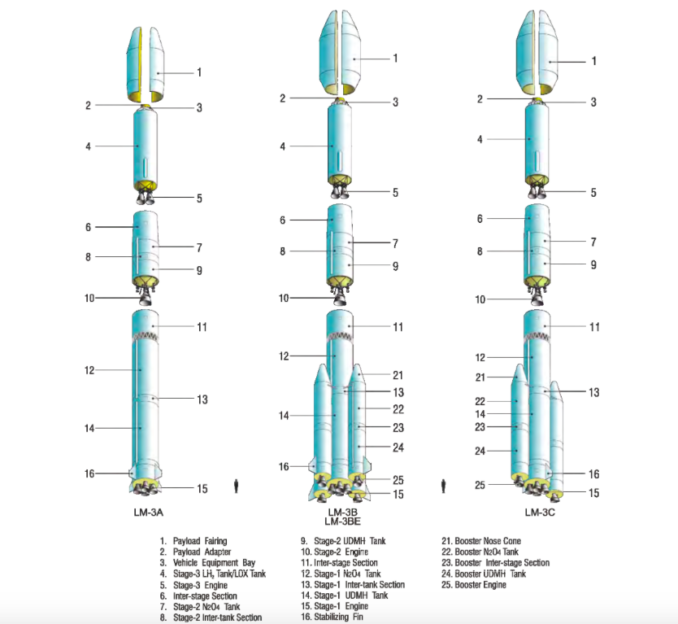Featured image credit: Xinhua / Zhu Zheng
Lift Off Time | July 12, 2022 – 16:30 UTC July 13, 2022 – 00:30 BJT |
|---|---|
Mission Name | Tianlian 2-03 |
Launch Provider | China Academy of Launch Vehicle Technology (CALT) |
Customer | China Aerospace Science and Technology Corporation (CASC) |
Rocket | Long March 3B/E |
Launch Location | Xichang Satellite Launch Center, Sichuan Province, China |
Payload mass | Maximum of 5,500 kg to GTO |
Where did the satellite go? | Geostationary Earth Orbit (GEO) |
Did they attempt to recover the first stage? | No, this is not a capability of the Long March 3B/E |
Where did the first stage land? | It crashed on land in mainland China |
Did they attempt to recover the fairings? | No, this is not a capability of the Long March 3B/E |
Were these fairings new? | Yes |
This was the: | – 23rd China’s orbital launch of 2022 – 143rd flight of a Long March 3 (any variant) – 81st orbital launch attempt of 2022 (79th successful) |
Where to re-watch | If available, an official replay will be listed here |
How Did It Go?
The China Aerospace Science and Technology Corporation (CASC) successfully launched the Tianlian 2-03 satellite atop a Long March 3B/E rocket, marking China’s third successful launch of the Tianlian-2 satellites. The satellite joins the two other Tianlian-2 satellites currently in geostationary orbit (GEO), providing communications coverage for the Shenzhou missions and the Tiangong Space Station.
Tianlian 2-03 Mission
Tianlian-2 is a series of tracking and data relay satellites. They form a constellation in GEO and support other satellites in low Earth orbit (LEO) and medium Earth orbit (MEO). The system is also used to communicate between the Chinese Space Station and Beijing.
The first generation of Tianlian satellites (Tianlian-1) were built around the DFH-3 satellite bus (a three-axis-stabilized telecommunications satellite platform), and functionally the series is similar to the United States Tracking and Data Relay Satellite System. It used S-band radio with 2 GHz frequency. Each of the Tianlian-1 satellites were launched atop a Long March 3C rocket into a GEO.
In contrast, Tianlian-2 was developed around the DFH-4 satellite bus produced by the China Academy of Space Technology. It uses K-band radio with a frequency in excess of 20 GHz and is able to connect to more spacecraft at the same time. The Tianlian-2 satellites are supporting rendezvous, docking operations, and spacewalks at China’s Tiangong space station, as well as communication between astronauts and ground stations. The Tianlian 2-01 was launched on 31 March 2019 and the Tianlian 2-02 on 14 December 2021.
What Is The Long March 3B/E?
Despite the Chinese rockets having different heritages, most of China’s orbital launch vehicles use the “Long March” (Chang Zheng) naming scheme. The Long March 3B is a three stage rocket, with an optional fourth stage. The rocket has four liquid-fueled side boosters, and first launched in 1996.
The Long March 3B/E, the enhanced version of the Long March 3B, was first launched in 2007 and has greater Geostationary Transfer Orbit (GTO) payload capacity. The enhanced 3B/E rockets have a larger first stage and larger side boosters, compared to the original Long March 3B. As a result, its payload capacity to GTO increased from 5,100 kg to 5,500 kg.
The Long March 3B series features the following sections or stages:
- Side boosters
- First (center) stage (ignited at launch)
- Second stage
- Third stage
- Optional fourth stage
Side Boosters
There are 4 side boosters that each use one YF-25 engine, which is powered by Unsymmetrical Di-Methyl Hydrazine (UDMH) and Nitrogen Tetroxide (N2O4).
The regular Long March 3B’s side boosters are 15.33 m (50.3 ft) long, but on the enhanced version they are 16.1 m (52.3 ft) long, producing 740 kN of thrust. The YF-25 engine has a specific impulse (ISP) of 260 seconds, and burns for 140 seconds on the 3B/E variant.
First (Center) Stage
The first stage has 4 YF-21C engines, which also use UDMH / N2O4 for propellant. The first stage has an ISP of 260 seconds and produces 2,960 kN of thrust. The LM-3B first stage is 23.27 m (76.35 ft) tall, but the 3B/E is 24.76 m (81.23 ft) tall.

Second Stage
The second stage is powered by a single YF-22E engine. However, attitude control is provided by a single YF-23 vernier engine, and combined, these engines are known as a YF-24 module. The engine runs on UDMH and N2O4 and produces 742 kN of thrust. The second stage is 12.9 m (42.3 ft) tall and burns for 185 seconds.

Third Stage
The third stage is 12.4 m (40.7 ft) long and is powered by 2 YF-75 engines. Unlike the other stages, this stage is powered by liquid hydrogen (LH2) and liquid oxygen (LOX).
The third stage will burn after the second stage is jettisoned, in order to continue to raise the orbital apogee (maximum altitude). Once the target apogee has been achieved, it shuts down. The vehicle will then coast to apogee, where the stage relights and burns to raise the perigee (lowest altitude) of the orbit.
Optional Fourth Stage
The fourth stage runs on UDMH / N2O4, and has a singular YF-50D engine. On the Tianlian 2-03 mission, the fourth stage was not used.





